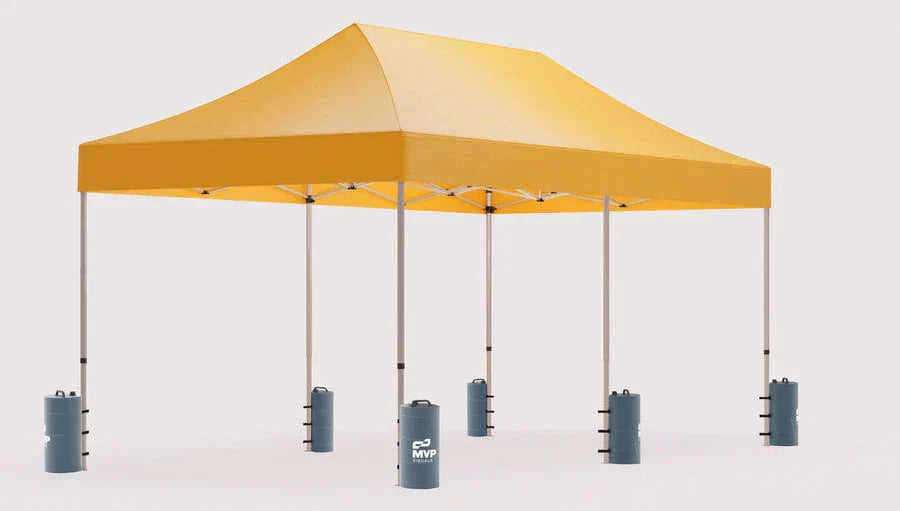Securing a canopy tent on concrete comes with its own set of challenges - unlike on grass, you can't just drive in some stakes and call it a day. Whether you're hosting a farmers market tent setup or a lively sports event, this guide is here to help you figure out the best way to anchor your tent on a hard surface.
We’ll cover everything from quick-to-setup water weight bags and reliable sandbags to sturdy weight plates and some DIY tricks to hold down a canopy tent on concrete. By the time you’re done reading, you’ll know exactly how to keep your tent stable and safe, no matter what the day throws at you.
Here’s a quick comparison of the top ways to anchor your canopy tent on concrete:
| Anchoring Method | Weight Range | Ease of Setup | Portability | Best For | Pros | Cons |
|---|---|---|---|---|---|---|
| Water Weight Bags | 20.5 lbs per bag | Easy | Highly portable | Short-term events | Easy to fill and transport, reusable | Requires a water source, limited weight |
| Sandbags | 30-50 lbs per bag | Moderate | Portable when empty | Windy conditions, general events | Cost-effective, customizable weight | Physically demanding to fill, can wear out |
| Weight Plates | 20-50 lbs per plate | Easy | Less portable | Formal or professional setups | Durable, sleek appearance, low profile | Heavier, more expensive, bulky to store |
| Concrete Weights | 50-500+ lbs | Difficult | Not portable | Semi-permanent installations | Extremely stable, long-lasting | Very heavy, costly to move and install |
| DIY Solutions | Varies (10-50 lbs+) | Varies | Varies | Budget setups, flexible use | Cost-effective, customizable | Requires time and effort, must meet safety standards |
1. Water Weight Bags for Anchoring Canopy Tents on Concrete
 Designed for concrete surfaces, our water-filled weight bags keep your canopy stable and secure.
Designed for concrete surfaces, our water-filled weight bags keep your canopy stable and secure.
Water weight bags are a simple yet effective way to secure your canopy tent on concrete. Once filled, each bag adds about 20.5 pounds of weight, giving your tent the stability it needs in typical weather conditions. These bags are easy to set up, easy to move, and tough enough to handle various weather challenges, making them a go-to choice for event organizers who need a reliable anchoring solution.
Anchoring Effectiveness and Practical Use
- Weight Specifications: Typically, filling each bag with water provides around 20.5 pounds of weight, suitable for stabilizing canopies in moderate weather conditions.
- Anchoring Efficiency: It is recommended to place one water weight bag at each corner of a 10x10 foot canopy to maintain stability. In areas prone to high winds, additional anchoring strategies may be necessary.

Pros
- Ease of Setup: Quick and easy to fill, these bags streamline the anchoring process.
- Durability: Made from waterproof tarpaulin with heat-welded seams, these bags are built to prevent leaks and withstand wear and tear.
- Secure Attachment: Equipped with specially designed straps, these bags attach firmly to canopy legs, reducing the need for ongoing adjustments.
Cons
- Weight Limitations: The 20.5 pounds provided by each bag may not suffice in very windy conditions, requiring further reinforcement.
- Water Source Dependence: Effective use depends on having access to a water supply, which might not be available at all venues.
- Maintenance Needs: When not in use, these bags should be dried and stored properly to avoid issues such as mildew.
2. Sandbags for Holding Down Canopy Tents on Concrete

Sandbags are a tried-and-true option for securing canopy tents on concrete, thanks to their simplicity and effectiveness. They’re lightweight and easy to transport when empty, and you can fill them up on-site, making them perfect for quick setups.
Each sandbag can hold between 30 to 50 pounds of sand, offering the strong anchorage you need to keep your tent stable, even on hard concrete surfaces and in windy conditions.
Anchoring Effectiveness and Practical Use
- Weight Specifications: Standard sandbags can weigh between 30 to 50 pounds when filled with sand.
- Anchoring Efficiency: For a 10x10 foot canopy, using one sandbag on each leg is generally sufficient. In windier conditions, additional weight might be necessary, achievable by adding larger bags or multiple bags per leg.
Pros
- Portable and Convenient: Easily carried when empty and filled on-site.
- Cost-Effective: Sandbags are an affordable anchoring option, with costs primarily limited to the bags and the fill material.
- Customizable Weight: The filling amount can be adjusted to meet specific event requirements and weather conditions.
Cons
- Physical Effort Required: Filling and positioning sandbags can be physically demanding.
- Durability Concerns: Regular usage can lead to wear, requiring replacements over time.
- Aesthetic Considerations: Functional yet plain, sandbags may require covers or strategic placement to suit more formal event aesthetics.
3. Weight Plates for Holding Down Canopy Tents on Concrete

Weight plates, made from metal or heavy-duty composite materials, are a solid choice for anchoring canopy tents on concrete. These plates are designed to be placed directly under the tent’s feet or clamped around the legs, giving your tent a reliable hold that stands up to windy conditions. They’re a great option for those looking for a sleek and sturdy solution to keep their canopy stable on hard surfaces.
Anchoring Effectiveness and Practical Use
- Weight Specifications: Weight plates typically range from 20 to 50 pounds each. Depending on the size and design of the canopy, one plate per leg is often sufficient to anchor a standard 10x10 foot canopy effectively.
- Anchoring Efficiency: The solid weight of these plates makes them ideal for use on hard surfaces where other anchoring methods may fail. Their low profile also minimizes tripping hazards, making them a safe choice for busy event environments.
Pros
- Durability: These plates are built to last and resist corrosion, making them suitable for repeated use in outdoor settings.
- Ease of Installation: Simply place the weight plates on the base of the canopy legs or use the integrated clamping mechanism for a secure fit.
- Aesthetically Pleasing: Unlike sandbags, weight plates typically have a more polished appearance, fitting in well at professional or formal events.
Cons
- Heaviness: While effective, these plates can be quite heavy, potentially making transport and setup challenging without additional equipment.
- Cost: Generally, weight plates are more expensive than alternative methods like sandbags or water weight bags.
- Storage Requirements: Due to their solid and bulky nature, storing weight plates requires more space, which may be a consideration for those with limited storage capacity.
4. Concrete Weights for Semi-Permanent Canopy Structures on Concrete

Concrete weights are ideal for anchoring semi-permanent canopy structures on concrete. These heavy-duty, pre-cast blocks or custom-formed pads are designed to offer solid and reliable support, thanks to their significant weight and durability.
They’re practical for setups that need to stay in place for extended periods, providing stability without the hassle of frequent adjustments. However, because they’re so heavy, you’ll need to plan carefully for transportation and installation to make the most of them in your space.
Anchoring Effectiveness and Practical Use
- Weight Specifications: Concrete weights can vary significantly in size and weight, commonly ranging from 50 to over 500 pounds, depending on the required stability and the size of the canopy.
- Anchoring Efficiency: For semi-permanent structures, concrete weights provide a reliable anchoring solution that withstands weather elements and prevents movement or tipping of the canopy in high winds. Their weight and solidity make them ideal for long-term installations where frequent repositioning is not necessary.
Pros
- Longevity: Concrete is highly durable and can withstand the elements without deterioration, making it suitable for long-term use.
- High Stability: The sheer mass of concrete weights ensures a strong hold, minimizing the risk of the canopy shifting or being uplifted by wind.
- Low Maintenance: Once in place, concrete weights require little to no maintenance, serving as a set-it-and-forget-it solution.
Cons
- Immobility: Due to their weight, concrete blocks are difficult to move and typically require machinery to position, making them less ideal for events or uses that require mobility.
- Cost of Transportation and Installation: The initial logistics of moving and installing concrete weights can be costly and require planning.
- Aesthetic Considerations: While functional, concrete weights may require cosmetic adjustments such as painting or covering to enhance their appearance for use in visible areas of event spaces.
5. DIY Ways to Secure Your Canopy on Hard Surfaces
DIY tent anchor solutions are a flexible and budget-friendly way to secure your tent on concrete, where traditional stakes just won’t work. Whether you’re using buckets filled with concrete, PVC pipes, or sand-filled water jugs, these methods can be customized to fit your event's specific needs.
It’s important to make sure your DIY anchors meet the guidelines and regulations of the event you’re attending. For example, some markets, like High Desert Farmers Market, require at least 40 pounds of weight per canopy leg. Following safety standards is key to preventing accidents and keeping your tent stable, especially when the weather is unpredictable.

1. Bucket Filled with Concrete
- Description: Use a 5-gallon bucket and fill it with pre-mixed concrete. Before the concrete sets, insert a heavy-duty eye bolt into the center to create an anchor point. Ensure the concrete is level and fully set before use.
- Pros: Highly durable and customizable in weight by adjusting the amount of concrete.
- Cons: Each bucket can weigh 80-100 pounds, making it heavy and difficult to transport. Consider adding handles or wheels for easier mobility.
2. PVC Pipe Weights
- Description: Cut a PVC pipe into 2-3 foot sections, cap one end, and fill with concrete. Insert an eyebolt into the wet concrete before capping the other end. Allow the concrete to cure for at least 24 hours. Attach the pipes to the tent legs using strong bungee cords or ropes.
- Pros: Customizable size and weight; provides a neat, organized look around the canopy
- Cons: Heavy and cumbersome to transport. Ensure the eyebolt is securely embedded to prevent it from loosening over time.
3. Sand-Filled Water Jugs
- Description: Large water jugs filled with sand provide a manageable weight that can be attached using ropes or bungee cords.
- Pros: Lightweight when empty, making them easy to transport and fill on-site. They are also easier to handle and reposition compared to concrete weights.
- Cons: You may need multiple jugs per leg to achieve the necessary stability, especially in windy conditions.
4. Modified Cinder Blocks
- Description: Use standard cinder blocks and modify them by attaching metal hooks or eye bolts, which allow the blocks to be secured to canopy legs with ropes or chains. Each block provides a stable and heavy anchor point, typically weighing 25-35 pounds.
- Pros: Cost-effective, widely available, and sturdy. These blocks offer a solid base for anchoring canopies on concrete.
- Cons: Bulky and heavy, making them difficult to transport and position. The rough edges may require careful handling to avoid damage to ropes or tent fabric.
5. Home-Made Bag Weights
- Description: Create custom bags using durable fabric, and fill them with sand or gravel to use as weights for your canopy. These bags can be sewn to fit your desired size and weight, then securely attached to the tent legs.
- Pros: Fully customizable in terms of size, weight, and appearance, making them both functional and aesthetically pleasing.
- Cons: Requires time, sewing skills, and access to materials. The preparation process can be labor-intensive, especially for large events or multiple canopies.
 Effortlessly secure your canopy on concrete with our water-filled weight bags, designed for quick and easy setup.
Effortlessly secure your canopy on concrete with our water-filled weight bags, designed for quick and easy setup.
Anchor Right, Stay Secure:
With several options for anchoring your canopy on concrete, you can choose the method that best fits your needs, balancing cost, effectiveness, and portability. For instance, if you’re expecting windy conditions, concrete weights or sandbags offer the stability you need.
For a quick setup at a short event, water weight bags provide a convenient and portable solution. By selecting the right approach, you’ll ensure that your canopy stays firmly in place, allowing you to focus on the success of your event without worry.



